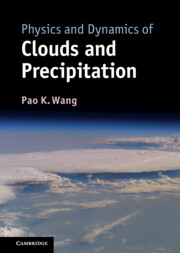Book contents
- Frontmatter
- Contents
- Preface
- 1 Observation of clouds
- 2 The shape and size of cloud and precipitation particles
- 3 Molecular structures of water substance
- 4 Bulk thermodynamic equilibrium among water vapor, liquid water, and ice
- 5 Surface thermodynamics of water substance
- 6 Aerosol in the atmosphere
- 7 Nucleation
- 8 Hydrodynamics of cloud and precipitation particles
- 9 Diffusion growth and evaporation of cloud and precipitation particles
- 10 Collision, coalescence, breakup, and melting
- 11 Cloud drop population dynamics in the warm rain process
- 12 Fundamental cloud dynamics
- 13 Numerical cloud models
- 14 Cloud electricity
- 15 Clouds–environment interaction
- References
- Index
- Plate section
15 - Clouds–environment interaction
Published online by Cambridge University Press: 05 March 2013
- Frontmatter
- Contents
- Preface
- 1 Observation of clouds
- 2 The shape and size of cloud and precipitation particles
- 3 Molecular structures of water substance
- 4 Bulk thermodynamic equilibrium among water vapor, liquid water, and ice
- 5 Surface thermodynamics of water substance
- 6 Aerosol in the atmosphere
- 7 Nucleation
- 8 Hydrodynamics of cloud and precipitation particles
- 9 Diffusion growth and evaporation of cloud and precipitation particles
- 10 Collision, coalescence, breakup, and melting
- 11 Cloud drop population dynamics in the warm rain process
- 12 Fundamental cloud dynamics
- 13 Numerical cloud models
- 14 Cloud electricity
- 15 Clouds–environment interaction
- References
- Index
- Plate section
Summary
Up to now we have been studying the internal physics and chemistry of cloud systems – some large and some small – without thinking too much about how clouds influence their environments. In other words, we consider a cloud as if it is an isolated system. But we know that clouds cannot be really separated from the rest of the atmosphere, and the formation or dissipation of a cloud will ultimately change its environment. How clouds influence the atmosphere, or, more fundamentally, how clouds and their atmospheric environments interact with each other, is a complicated question that requires more research to clarify. In this chapter, we will discuss some relevant issues in this area.
Clouds and atmospheric chemistry
The formation of clouds has much to do with chemistry, as we have discussed previously, especially in the chapters on aerosols and nucleation. Conversely, the formation of clouds also greatly influences the chemistry of the atmosphere. First of all, once an aerosol particle nucleates a cloud drop or an ice crystal, it begins to be involved in the cloud and precipitation process, and ultimately it may be removed from the atmosphere if it falls with the precipitation. Even those aerosol particles that are not involved in the nucleation process (called the interstitial aerosol) may be washed out by the cloud and precipitation particles. Similarly, trace gases such as SO2, NH3, NO2, and CO2, etc., can be absorbed by cloud and raindrops and turn into other chemicals, which may then be involved in further chemical reactions (such as the production of acid precipitation). In the following sections, we will discuss some aspects of the cloud impacts on atmospheric chemistry.
- Type
- Chapter
- Information
- Physics and Dynamics of Clouds and Precipitation , pp. 396 - 428Publisher: Cambridge University PressPrint publication year: 2013



